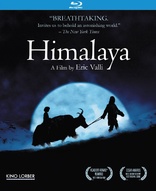Himalaya Blu-ray Movie
HomeHimalaya Blu-ray Movie 
Kino Lorber | 1999 | 108 min | Not rated | Dec 31, 2013Movie rating
7.2 | / 10 |
Blu-ray rating
| Users | 0.0 | |
| Reviewer | 4.0 | |
| Overall | 4.0 |
Overview
Himalaya (1999)
An aging chief's last stand, lessons for the new, and the education of a young chief-to-be played against harsh Nature in Nepal's Dolpo. When his son dies returning from Tibet's salt lakes, Tinle blames Karma, his son's friend, refuses to give Karma his blessing as the new chief, and organizes a rival caravan to take the salt to lower Nepal to trade for grain. He, a few old men, his son's widow, his grandson, and his second son, a monk, set out on the arduous journey.
Starring: Gurgon Kyap, Lhakpa Tsamchoe, Thilen LhondupDirector: Eric Valli
| Foreign | 100% |
| Drama | 22% |
Specifications
Video
Video codec: MPEG-4 AVC
Video resolution: 1080p
Aspect ratio: 2.35:1
Original aspect ratio: 2.39:1
Audio
Tibetan: DTS-HD Master Audio 5.1
Subtitles
English
Discs
50GB Blu-ray Disc
Single disc (1 BD)
Playback
Region A (B, C untested)
Review
Rating summary
| Movie | 4.0 | |
| Video | 4.5 | |
| Audio | 4.5 | |
| Extras | 3.0 | |
| Overall | 4.0 |
Himalaya Blu-ray Movie Review
Over the Mountains, Through the Snow
Reviewed by Casey Broadwater January 9, 2014The story that unfolds in Himalaya—set deep in the mountainous Dolpa region of rural Tibet—is completely timeless. That is, the film was shot
and presumably set in 1999, but it could easily take place anytime in the past several hundred years, as the culture of the villagers in this area has
changed little over the centuries. In all of Dolpa, in fact—as of 2012—there is exactly one automobile. The people there live exclusively off the
land, mining salt, harvesting wheat, and tending herds of yak. The ancient traditions still hold sway—the rites of tribal succession, the hand-sewn
clothing, the superstitions of an animist, astrological strain of Buddhism—but we might naturally wonder how long the old ways can continue running
contrary to a modern world that's increasingly global and connected.
The film, then, is a bit of time-capsule ethnography, capturing a way of life that may soon cease to exist. Himalaya's director, Éric Valli, is and
was particularly well-suited to this task. A longtime photographer and documentarian for National Geographic and The Sunday Times, Valli spent years
living in and traipsing through remote Tibet before applying his expertise to this, his first feature film, which was made almost entirely with local, non-
professional actors in areas only accessible by foot.
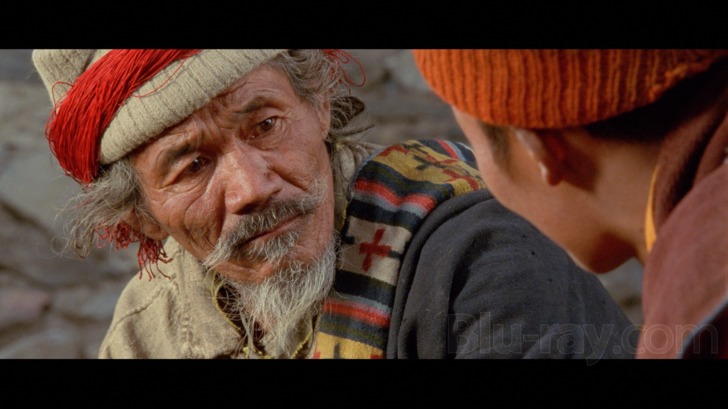
Tinle
Himalaya's narrative is a simple story of power, pride, and stubbornness in a village high in the mountains. The village chief, Tinle (Thinien Lhondup), is advancing in years but rests comfortably in the knowledge that his son, Lhakpa, and his son's son, Tsering (Karma Wangiel), will eventually succeed him. This direct line of succession falls into question, however, when Lhakpa dies on one of the tribe's semi-annual caravan trips through the Himalayas to sell their harvests of wheat and salt. Tinle is convinced that Lhakpa's best friend and second-in-command, Karma (Gurgon Kyap)—in what he imagines as a surreptitious bid to usurp the throne—is somehow responsible for his son's death.
With Tinle too old to lead and Tsering still too young, Karma is the village council's natural choice to take over as acting chief. Tinle, of course, will have none of this, and goes off to the nearby monastery to ask his younger son, the monk Norbou (Karma Tensing), to quit his life of piety and take over leadership of the tribe. Meanwhile, Karma—who is every bit as obstinate as Tinle—refuses to heed the local lamas' astrological predictions about when to leave on the next caravan, and sets off with the village's young men on the dangerous journey to the nearest trading town. When Tinle discovers that Karma has struck out on his own, he gathers together the village's old men—along with the rest of the harvest—and leads his own caravan, his first in over a decade. Tinle's pride pushes him to try to catch up with Karma, a feat that necessitates taking the "Demon's Path," a treacherous shortcut filled with narrow ledges and hundred-foot drops.
The film's greatest shortcoming is that—aside from this high-stakes journey through the Demon's Path—the story often feels slight and inconsequential, as if the minimal drama is here only in the service of showcasing the spectacular Himalayan scenery, and not the other way around. The simplicity does give Himalaya a fable-like quality, though, arriving at an Aesop-worthy moral about how the flaws we observe in others are often reflections of our own. Tinle and Karma are very much alike, of course; the old-age obstinance of the former is no different from the latter's youthful rebelliousness. They're basically the same man at two different stages in life.
The low-impact script gives us few emotional handholds, but the film's picturebook exoticism is certainly enough to carry our attention from one scene to the next. Himalaya is, in one sense, a moving Nat-Geo photo spread, illustrating the hard-knock existence of these real-life villagers, who live in a place most would consider inhospitable at best, and bordering on uninhabitable at its worst. We see the gruesome glory of a Tibetan sky funeral. We watch the leather-faced old women rhythmically washing clothes in brackish water. We follow along on a ten-day journey over sun-burnt peaks and through snowy valleys. In the distance, always, the mountains stretch as far as can be seen. If nothing else, Himalaya is a gorgeous film from start to finish, shot in a 2.35:1 Cinemascope ratio that's perfect for emphasizing the endlessness of the craggy vistas that will stand long after the last caravan has left.
Himalaya Blu-ray Movie, Video Quality 
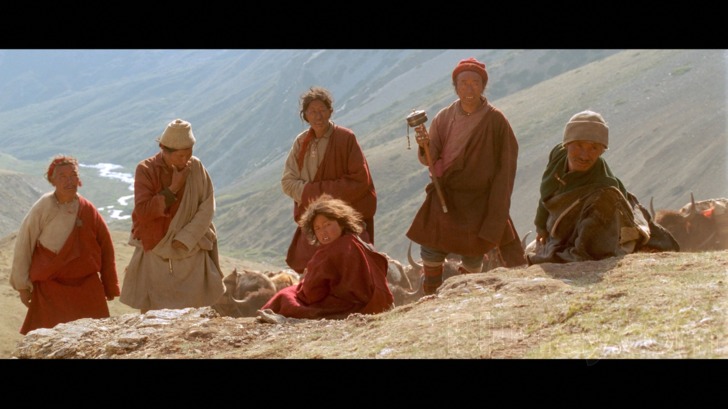
This is one of the best-looking transfers Kino-Lorber has put out in recent memory. Himalaya's new 1080p/AVC-encoded remaster is a nearly perfect showcase of the stunning 35mm Cinemascope work of cinematographers Eric Guichard (HBO's Sometimes In April) and Jean-Paul Meurisse (Europa). Aside from a few fleeting specks here and there, the print is in ideal condition and—with its natural grain patterns intact— shows no signs of excessive digital tampering. No noise reduction, no edge enhancement, no over-the-top color or contrast boosting. The film has a strikingly realistic look to begin with, and seeing it in HD for the first time makes it even more impressive; the transfer has a vivid, dimensional quality that's almost reminiscent of 70mm IMAX photography. (Maybe I'm just thinking of the the Tibet sections of last year's Samsara.) There are rare softish shots, but most of the time, clarity is exceptional, revealing the finest contours of the non-actors' legitimately weather-beaten, wind-creased faces and the intricate stitching of their hand-sewn clothing. Color is graded and balanced excellently too, with properly exposed skies—tricky when shooting in full sun at high elevations—and grounded black levels. If you own and love the film on DVD, the Blu-ray is definitely a worthwhile upgrade.
Himalaya Blu-ray Movie, Audio Quality 
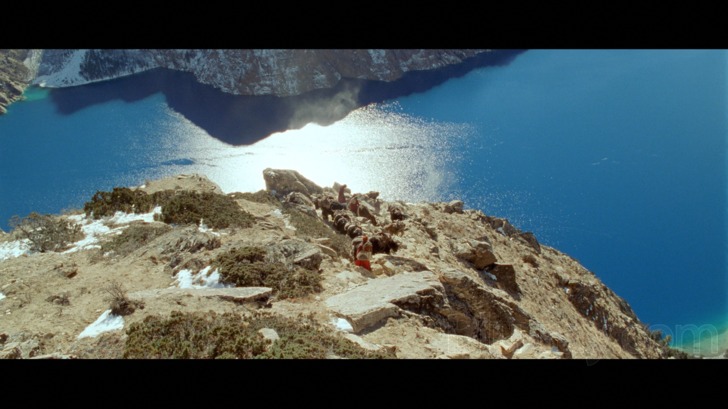
Likewise, the film's Tibetan DTS-HD Master Audio 5.1 surround track is fantastic. At the core of the mix is a lush score from French composer Bruno Coulais (The Secret of Kells), who blends in Tibetan elements—like the atonal chanting of Buddhist monks—with more typical orchestral arrangements. The music is sweeping and forceful—maybe even a bit too much so for certain scenes—and it sounds wonderfully rich when you crank it up a notch or two above your normal listening level. The soundfield is additionally filled out with all sorts of environmental ambience; buzzards caw in the rear speakers, herds of yaks stampede down a dusty pathway, wind whips mercilessly and rocks crumble and fall. Throughout it all, dialogue is clean and balanced and easy to comprehend with the aid of the optional English subtitles.
Himalaya Blu-ray Movie, Special Features and Extras 
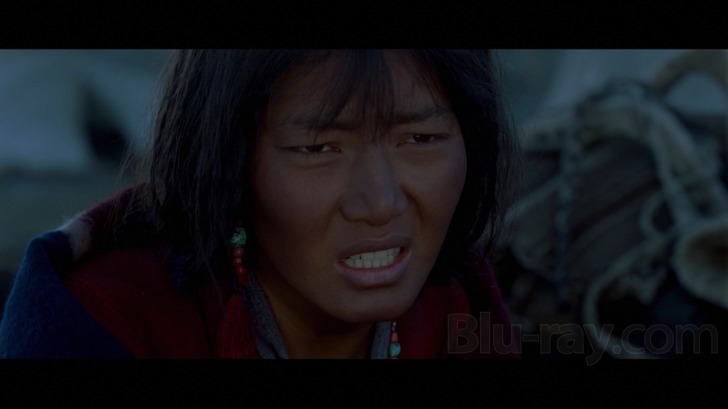
- Audio Commentary: Director Eric Valli and filmmaker/journalist Debra Kellner—who acts as moderator/interviewer—discuss the making of the film, Valli's time living in Tibet, and the real stories that inspired the script.
- The Making of Himalaya (SD, 27:11): Debra Kellner followed the production through the mountains to create this excellent making-of documentary, which chronicles the on-location challenges of shooting in some of the toughest terrain on Earth.
- Electronic Press Kit: A collection of behind-the-scenes featurettes, clips from the film, and promotional materials.
- TV Promo Trailer (SD, 1:37)
- Yaks on a Cliff (SD, 1:27)
- Karma Leads A Caravan (SD, 1:31)
- Tinle and Norbou (SD, 1:05)
- Karma Wangiel On Set (SD, 1:19)
- Theatrical Trailer (SD, 1:48)
Himalaya Blu-ray Movie, Overall Score and Recommendation 
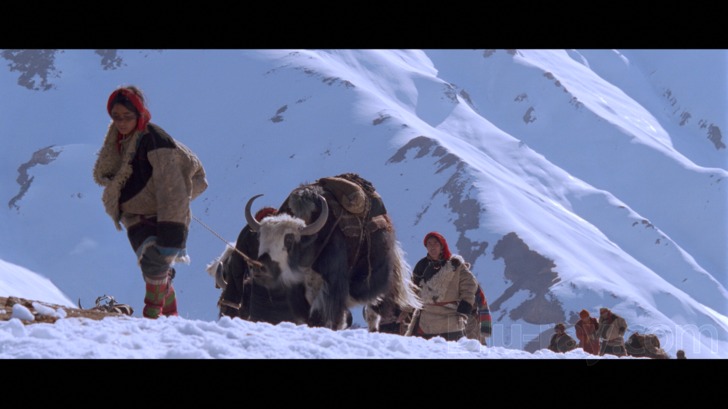
Éric Valli's Himalaya is one part Tibetan fable, one part moving National Geographic photo spread, and one part time capsule of a timeless culture. What it lacks in drama, it more than makes up in sheer ethnological interestingness, documenting a way of life that's tough, beautiful, and quickly disappearing. (Plus, the stunning cinematography of the high Himalayas is worthwhile in and of itself.) Kino-Lorber's Blu-ray release is all-around excellent as well, with a striking new high definition transfer, a lossless audio track, and a selection of informative special features. Recommended!
Similar titles
Similar titles you might also like

The Rocket
2013

Secret Sunshine
밀양 / Milyang
2007

The Ballad of Narayama
楢山節考 / Narayama bushikô
1958

La Belle Noiseuse
The Beautiful Troublemaker
1991

The Viral Factor
逆戰
2012

Hard to Be a God
Трудно быть Богом
2013

Black Robe
1991

El Pico
Overdose
1983

The Valley (Obscured by Clouds)
La Vallée
1972

Taxi
2015

Zama
2017

A Story of Floating Weeds
浮草物語
1934

Neon Bull
Boi Neon
2015

Julieta
2016

The Ballad of Narayama
Narayama-bushi kô
1983

Spring, Summer, Fall, Winter...and Spring
2003

Shoplifters
万引き家族 / Manbiki kazoku
2018

Diary of a Lost Girl
Tagebuch einer Verlorenen
1929

Things to Come
L'avenir
2016

Right Now, Wrong Then
지금은맞고그때는틀리다
2015
